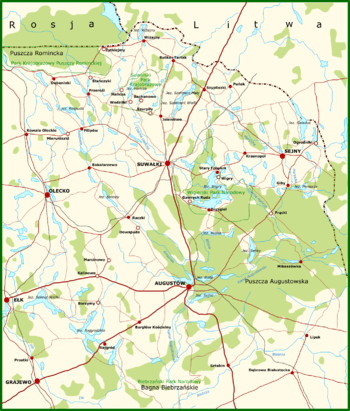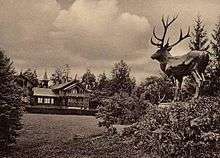Romincka Forest
Romincka Forest (Polish: Puszcza Romincka, Lithuanian: Romintos giria), also known as Krasny Les (Russian: Красный лес) or Rominte Heath (German: Rominter Heide), is an extended forest and heath landscape stretching from the southeast of Russian Kaliningrad Oblast to a the northeast of Polish Warmian-Masurian Voivodeship. The palaearctic ecoregion is part of the Taiga and boreal forests biome.
Etymology
The Polish and German names of the forest, like the Rominta/Rominte river and the settlement of Rominty/Rominten, are derived from the Lithuanian syllable rom, meaning calm, as the forest is in the land called Lithuania Minor. The Russian name, Krasny Les, means "Red Forest".
Geography

The total area of the Romincka landscape is about 250 square kilometres (97 sq mi), stretching from the Masurian Lake District in the southwest up to the border with Lithuania at Lake Vištytis in the east. The southern Polish part (about one-third of the area) comprises a protected zone known as Puszcza Romincka Landscape Park.
The Krasnaya River flows through the Romincka Forest. Major settlements in the area include Krasnolesye in Kaliningrad Oblast, as well as Żytkiejmy and Gołdap in Poland.
History

Part of the East Prussian historic region, the extended forests were known for its red deer populations and became a popular hunting ground of the Hohenzollern princes ruling the Duchy of Prussia since 1525. Part of the German Empire from 1871 onwards, a vast premise in Rominter Heide was purchased by Emperor Wilhelm II, who had his Rominten Hunting Lodge erected here in 1891, including a chapel dedicated to Saint Hubertus. Hunt scenes were perpetuated by notable painters such as Richard Friese (1854–1918).
Plundered by Russian forces in World War I, the hunting lodge and grounds upon Wilhelm's resignation in 1918 were administrated by the Free State of Prussia; Minister-President Otto Braun was a regular guest. Later on, the estates were seized by Nazi minister Hermann Göring, whose Reichsjägerhof Rominten was built nearby in 1936. It also served as Göring's headquarters during the German Operation Barbarossa in 1941.
The Allied Potsdam Agreement after World War II divided the region between the re-established Polish Republic and the Soviet Union. The German history of the region is documented at the East Prussian State Museum in Lüneburg and at the German Hunting and Fishing Museum in Munich. In recent years, hunting tourism has again become popular.
See also
- Index: Taiga and boreal forests Ecoregion
Coordinates: 54°22′18″N 22°31′17″E / 54.37167°N 22.52139°E